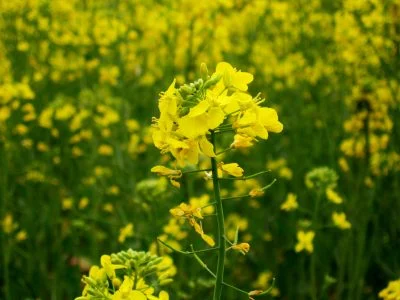India’s GM Mustard and the 30-Year Path to Food Tyranny
ORGANIC, GMO, GENETIC ENGINEERING, 31 Oct 2022
Colin Todhunter | Global Research - TRANSCEND Media Service
27 Oct 2022 – A public interest litigation is currently before India’s Supreme Court which challenges the drive to commercialise the growing of genetically modified (GM) mustard in India. On 26 October 2022, however, the country’s apex regulatory body – the Genetic Engineering Appraisal Committee – sanctioned commercialisation of the crop.
The central government has in the past stated commercialisation will not go ahead prior to the court’s decision, but this remains to be seen.
Approval is a significant moment for the agri biotech industry, not least because GM mustard can be regarded as a pioneering crop that could open the doors to a range of other GM food crops that are in the pipeline.
At this point, only one GM crop is legally cultivated in India, Bt cotton – designed to resist certain pests. Prominent policy makers and lobbyists have been claiming that, due to the success of Bt cotton, it should serve as a template for the introduction of GM food crops.
But this claim is not grounded in reality. Bt cotton has been far from successful and has caused immense hardship for cotton farmers (in fact, it is a template for a monumental catastrophe). This is evidentially supported by Prof Andrew Paul Gutierrez, Dr Hans R Herren and Dr Peter E Kenmore, internationally renowned agricultural researchers.
In India, Bt cotton is a failing technology that has severely negatively impacted many farmers. And before anyone says that farmers in India have consciously opted for GM cotton, they should read what researcher and academic Andrew Flachs says.
Flachs conducted fieldwork on cotton cultivation in the South Indian state of Telangana. His book Cultivating Knowledge: Biotechnology, Sustainability and the Human Cost of Cotton Capitalism in India reveals the ugly reality of ‘choice’ and cotton cultivation on the ground.
Consider too that what is happening also goes against the recommendations of four high-level reports that have advised against the adoption of GM crops in India.
The article Agri Biotech Motivated by Monopoly Control (25 October 2022) lists these reports and describes how – through deception, scientific fraud, technological sleight of hand and regulatory jugglery – GM mustard is designed (once commercialised) to facilitate the process of (chemical-dependent) GM food crop cultivation in India.
The premise behind GM mustard is to increase yields and reduce the import bill for edible oils. However, as the article mentioned above shows, there is actually no trait for yield and this GM mustard does not outperform conventional varieties. Moreover, the increase in edible oil imports is not due to low productivity of India’s indigenous edible oils sector but the political decision to cut tarrifs on imports at the behest of global agri commodity traders.
Official reports have been scathing about India’s regulatory system for GMOs, highlighting its inadequacies and inherent serious conflicts of interest. One can only assume that given there is no need (the key prerequisite for introducing a GM crop) for GM mustard, there are other motives for its promotion.
The GM project is not about the industry’s much-touted PR slogans of ‘feeding the world’ or helping farmers’. For the sake of brevity, readers can consult the online article Challenging the Flawed Premise Behind Pushing GMOs into Indian Agriculture which dismantles these claims.
Regardless of any claimed benefits, GMOs have first and foremost been about value capture and creating market dependency. They are also about securing ownership of seed germplasm developed over centuries by farmers via acquiring intellectual property rights – corporations claim their genetic manipulation (no matter how fruitless the effect) turns a seed into a patentable product. This would restrict farmers’ access to seeds and place the biotech companies in control of cultivation and breeding.
Where India is concerned, the GM project must also be viewed as forming part of a wider dependency paradigm. There has been a three-decades-long plan to restructure the Indian economy and Indian agriculture. The plan stems from the country’s 1991 foreign exchange crisis which was used to impose IMF-World Bank debt-related ‘structural adjustment’ conditionalities.
The details of this plan appear in a 2021 article by the Mumbai-based Research Unit for Political Economy – Modi’s Farm Produce Act Was Authored Thirty Years Ago in Washington DC. Although focusing on now-repealed (due to farmer protests) farm legislation, the article locates agricultural ‘reforms’ within a broader process of Western imperialism’s increasing capture of the Indian economy.
We often hear of the need to embrace technology and ‘modern agriculture’. On the surface, all well and good. But what this really means is acquiescing to the needs of global (GM) seed and agrichemical corporations and commodity traders: fitting into global supply chains that siphon value from the food system into the hands of the billionaires who own these conglomerates (we should not forget that Bt cotton enabled Monsanto to suck hundtreds of millions of dollars from poor cotton farmers).
To achieve this, where India is concerned, it means destroying self-reliant, indigenous systems of production by deliberately making smallholder farming financially non-viable, dismantling public buffer food stocks and state-backed price support mechanisms and distribution systems.
Having cleared the way for corporate interests to control the policy space left open by the retreat of the public sector and to amalgamate farms to entrench industrial-scale agriculture, the Indian government would then be compelled to attract ‘foreign direct investment’ by implementing further neoliberal reforms. This would build up foreign reserves which would then be used to purchase agricultural commodities on the international market.
The type of ‘food security’ demanded by ‘modern agriculture’ means eradicating self-sufficiency and implementing food-import dependency on unscrupulous global conglomerates and volatile markets vulnerable to manipulation and shocks (as we are currently witnessing in 2022).
And that’s not all. Privately owned but taxpayer subsidised ‘modern agriculture’ imposes certain costs, including nutrient-poor food contaminated by GMOs and chemical additives, the use of toxic pesticides, spiralling rates of ill health, the degradation of soil, the pollution of waterways, the eradication of thriving ecosystems and the destruction of rural communities.
The GMO issue ties into the ‘development’ agenda being pushed on India. Powerful interests are being handed India’s agrifood sector on a plate and both farmers and consumers will pick up the tab.
The author is an independent writer. For more in-depth insight into what is described in this article, readers can access the free eBook, ‘Food, Dispossession and Dependency: Resisting the New World Order’ by clicking on this link.
____________________________________________
 Originally from the northwest of England, Colin Todhunter has spent many years in India. He has written extensively for the Bangalore-based Deccan Herald, New Indian Express and Morning Star (Britain). His articles have also appeared in many other newspapers, journals and books. His East by Northwest site is at: http://colintodhunter.blogspot.com.
Originally from the northwest of England, Colin Todhunter has spent many years in India. He has written extensively for the Bangalore-based Deccan Herald, New Indian Express and Morning Star (Britain). His articles have also appeared in many other newspapers, journals and books. His East by Northwest site is at: http://colintodhunter.blogspot.com.
Go to Original – globalresearch.ca
Tags: GMO, Genetic engineering, Genetic manipulation, India
DISCLAIMER: The statements, views and opinions expressed in pieces republished here are solely those of the authors and do not necessarily represent those of TMS. In accordance with title 17 U.S.C. section 107, this material is distributed without profit to those who have expressed a prior interest in receiving the included information for research and educational purposes. TMS has no affiliation whatsoever with the originator of this article nor is TMS endorsed or sponsored by the originator. “GO TO ORIGINAL” links are provided as a convenience to our readers and allow for verification of authenticity. However, as originating pages are often updated by their originating host sites, the versions posted may not match the versions our readers view when clicking the “GO TO ORIGINAL” links. This site contains copyrighted material the use of which has not always been specifically authorized by the copyright owner. We are making such material available in our efforts to advance understanding of environmental, political, human rights, economic, democracy, scientific, and social justice issues, etc. We believe this constitutes a ‘fair use’ of any such copyrighted material as provided for in section 107 of the US Copyright Law. In accordance with Title 17 U.S.C. Section 107, the material on this site is distributed without profit to those who have expressed a prior interest in receiving the included information for research and educational purposes. For more information go to: http://www.law.cornell.edu/uscode/17/107.shtml. If you wish to use copyrighted material from this site for purposes of your own that go beyond ‘fair use’, you must obtain permission from the copyright owner.
Read more
Click here to go to the current weekly digest or pick another article:
ORGANIC, GMO, GENETIC ENGINEERING:
